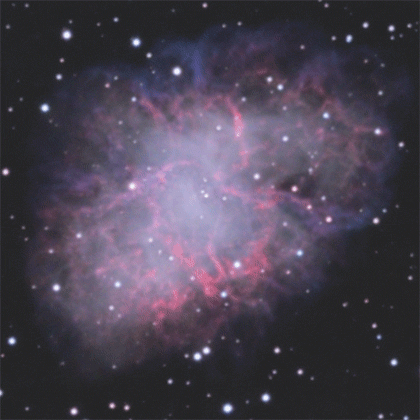What makes the crab nebula glow? The bluer of the two central stars is a dense neutron star,
the remnant of the original star that went supernova on the 4th, spinning at 30 revolutions per second. A strong magnetic field associated with the spinning star accelerates electrons in the surrounding space to relativistic speeds. Collisions between the electrons and surrounding matter give off very high energy photons. Rather than the central star, it is the photons from these collisions (EDIT: my physics buddies have informed me that it is the acceleration itself that causes the high energy photon emissions, no collisions needed) that cause the gas in the surrounding filaments to glow like fluorescent lights.
pulsar wind:
enamored with the concept of the pulsar wind, i attempted to capture it with a filter which blocks the emission line signal, giving only the broad band pulsar wind. a quick look at the crab nebula spectrum shows a wide region devoid of emission lines
after making a few calls, trying to get a nice wide filter in this region, i found a custom filter would cost more than my camera. so i went with a narrow filter in the region that was available in order to capture this broad band signal. i had hoped to capture some motion with the filter, but the broad band emissions were so weak with the narrow filter, that i was unable to get enough detail on any given night (or two) to convincingly demonstrate motion.
in any event, the combined stack gives a nice view of the pulsar wind without the pesky emission lines obscuring the view. i find the blink fascinating, tracing the swirls, wisps and arcs of broad band emission, and then following them into the combined image.
here's my 2011 crab nebula animation showing some motion in the broad band.
happy 4th
-bill w



No comments:
Post a Comment